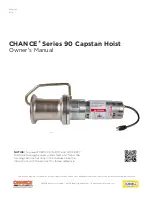
5
©2018 Hubbell Incorporated | Chance
®
Capstan Hoist Operating Instructions
Product Safety (cont.)
For Electric Models:
Do not use electrical wire sizes or types other than those specified or included with this product.
Protect extension cords from sharp objects, excessive heat, and damp or wet areas.
When connecting ANY electric models, observe the following:
• NEVER route electrical cables across sharp edges.
• NEVER route electrical cables near parts that get hot.
• NEVER route electrical cables through standing water.
• NEVER route electrical cables through or near moving parts.
When connecting 12 V DC electric models, ALSO observe the following as well:
• NEVER lean over a vehicle battery while making connections.
• NEVER route electrical cables over battery terminals.
• NEVER short battery terminals with metal objects.
• ALWAYS verify area is clear of fuel lines, fuel tank, brake lines, electrical wires, etc., if drilling is
required.
For Gasoline Models:
CARBON MONOXIDE HAZARD. Engine exhaust contains colorless and odorless carbon monoxide
gas. To prevent SERIOUS INJURY or DEATH, never operate gas powered motors in enclosed spaces
without adequate ventilation. Maintain the engine per the instructions supplied with the engine. When
any engine is stored for an extended period, the gasoline should be removed from the gas tank and
carburetor.
Refueling Information:
• When refueling with a portable container, it shall be equipped with an automatic closing cap and
flame arrester.
• Hoists shall not be refueled with the engine running or when the engine is hot.
• Fuel containers shall be stored in properly vented areas.
• Smoking, open flames, and the use of non-intrinsically safe devices shall be prohibited within 25 ft.
(7.62 m) of the refueling operation.
!
WARNING
For Hydraulic Models:
a) High Pressure Oil Hazard. To prevent serious injury or death:
• Relieve pressure before disconnecting hydraulic lines.
• Inspect hydraulic system for fluid leaks and pinholes. DO NOT use hands. Use a piece of cardboard
to detect leaks.
• If any amount of hydraulic fluid penetrates the skin, get medical help IMMEDIATELY.
b) Read and follow the guidance from the hydraulic system manufacturer related to the proper
personal protective equipment required for that system.
!
WARNING
!
WARNING






































